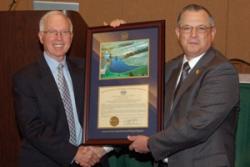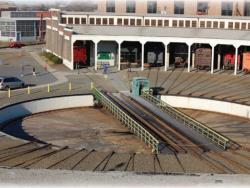Since 1948, over 11,000 dams and associated conservation practices in more than 2,000 watershed projects encompassing 160 million acres in 47 states have been constructed as a part of the USDA Small Watershed Program. These projects have improved the quality of life and the environment in rural communities by protecting people's lives and property, conserving soil and water resources, reducing flooding, providing economic development, recreation, and water supplies, enhancing water quality, and improving wetlands and wildlife habitat.
2011


The concept of once-over mechanical, as opposed to multiple-pick hand or experimental multiple-pick machine harvesting, represented a major break-through in the practice of producing vine fruit such as pickling cucumbers. In the 1950s the cost of hand harvesting was as high as 50% of the production cost. Once-over mechanical harvesting, coupled with increasing plant population, reduced this cost to 25% thereby making production economically viable.

In 1932, J. O. Smith, Agricultural Engineer at Delta Branch Experiment Station in Stoneville, MS, attached a small anhydrous ammonia cylinder to a plow in such a manner that the NH3 was released in the soil. The plow, a Georgia Stock, was pulled by a gray mule named Ike. This was the first known use of anhydrous ammonia as a soil-applied crop fertilizer. The crude apparatus and the anhydrous ammonia it applied provided a much needed source of nitrogen for the otherwise rich alluvial soils of the Mississippi Delta.

Getafe Airfield was the site of the world’s first successful rotorcraft flight, on January 17, 1923. Lieutenant Alejandro Gómez Spencer piloted a C.4 Autogiro designed and built by Juan de la Cierva, who tested a series of autogiros between 1920 and 1924 at the Getafe site. Cierva’s autogiros introduced important technologies and flight techniques that led to the development of helicopters and other rotary wing aircraft.
The roof system of this building, designed by Lev Zetlin and opened in 1960, was the first of its kind in the world. Before the mid-1950's, the use of long-span cable structures was generally limited to suspension bridges. The only other significant cable roof structure preceding the Utica Memorial Auditorium was the North Carolina State Fair Livestock Judging Pavilion, completed in 1953.

NHK began the world's first direct broadcast satellite service in May, 1984. This was the culmination of eighteen years of research that included the development of an inexpensive low-noise receiver and investigations of rain attenuation in the 12 GHz band. RRL, NASDA, TSCJ, Toshiba Corporation, General Electric Company, and NASA participated with NHK to make satellite broadcasting to the home a practical reality.
Operating since 1972, Eel River, New Brunswick is home to the world's first commercial solid state High Voltage Direct Current converter station. This 320 MW interconnection facility, built by Canadian General Electric and NB Power, incorporates high current silicon solid state thyristors to convert alternating current from Hydro Quebec to direct current and back to alternating, allowing asynchronous, stable power transfers to serve New Brunswick's Power's customers.

On 8 April 1911, Professor Heike Kamerlingh Onnes and his collaborators, Cornelis Dorsman, Gerrit Jan Flim, and Gilles Holst, discovered superconductivity. They observed that the resistance of mercury approached "practically zero" as its temperature was lowered to 3 kelvins. Today, superconductivity makes many electrical technologies possible, including Magnetic Resonance Imaging (MRI) and high-energy particle accelerators.


Designed in 1873 by Christopher Latham Sholes, with Carlos Glidden, Samuel Soulé and Mathias Schwalbach, the Sholes & Glidden 'Type Writer' was the first commercially successful device that rapidly printed alphanumeric characters on paper in any order.
Manufactured by E. Remington…
Read More
A majority of the buildings, used originally in steam locomotive repair and maintenance, are still intact, including the backshop (erecting shop), roundhouse, flue shop, paint shop, and parts storage buildings. The 37-stall roundhouse is one of the largest remaining roundhouses in North America…
Read More
Bremen Airport was founded in 1909. In 1924, German aviation pioneers Henrich Focke and Georg Wulf founded the Focke-Wulf company on the site. On June 26, 1936, Heinrich Focke’s Fw 61, the world’s first fully operational helicopter, made a successful maiden flight at the airport, piloted by…
Read More
Delta Air Lines’ historic buildings consist of two aircraft hangers and several office buildings at the Delta World Headquarters site constructed between 1941 and 1947. On March 1, 1941, Delta Air Lines moved its corporate headquarters to Atlanta, constructing offices space and Hangar 1, the…
Read More
Getafe Airfield was the site of the world’s first successful rotorcraft flight, on January 17, 1923. Lieutenant Alejandro Gómez Spencer piloted a C.4 Autogiro designed and built by Juan de la Cierva, who tested a series of autogiros between 1920 and 1924 at the Getafe site. Cierva’s autogiros…
Read More

On 8 April 1911, Professor Heike Kamerlingh Onnes and his collaborators, Cornelis Dorsman, Gerrit Jan Flim, and Gilles Holst, discovered superconductivity. They observed that the resistance of mercury approached "practically zero" as its temperature was lowered to 3 kelvins. Today,…
Read MoreOperating since 1972, Eel River, New Brunswick is home to the world's first commercial solid state High Voltage Direct Current converter station. This 320 MW interconnection facility, built by Canadian General Electric and NB Power, incorporates high current silicon solid state thyristors to…
Read More
NHK began the world's first direct broadcast satellite service in May, 1984. This was the culmination of eighteen years of research that included the development of an inexpensive low-noise receiver and investigations of rain attenuation in the 12 GHz band. RRL, NASDA, TSCJ, Toshiba Corporation…
Read MoreThe roof system of this building, designed by Lev Zetlin and opened in 1960, was the first of its kind in the world. Before the mid-1950's, the use of long-span cable structures was generally limited to suspension bridges. The only other significant cable roof structure preceding the Utica…
Read More
Getafe Airfield was the site of the world’s first successful rotorcraft flight, on January 17, 1923. Lieutenant Alejandro Gómez Spencer piloted a C.4 Autogiro designed and built by Juan de la Cierva, who tested a series of autogiros between 1920 and 1924 at the Getafe site. Cierva’s autogiros…
Read More
In 1932, J. O. Smith, Agricultural Engineer at Delta Branch Experiment Station in Stoneville, MS, attached a small anhydrous ammonia cylinder to a plow in such a manner that the NH3 was released in the soil. The plow, a Georgia Stock, was pulled by a gray mule named Ike. This was the…
Read More
The concept of once-over mechanical, as opposed to multiple-pick hand or experimental multiple-pick machine harvesting, represented a major break-through in the practice of producing vine fruit such as pickling cucumbers. In the 1950s the cost of hand harvesting was as high as 50% of the…
Read More
Since 1948, over 11,000 dams and associated conservation practices in more than 2,000 watershed projects encompassing 160 million acres in 47 states have been constructed as a part of the USDA Small Watershed Program. These projects have improved the quality of life and the environment in…
Read More

